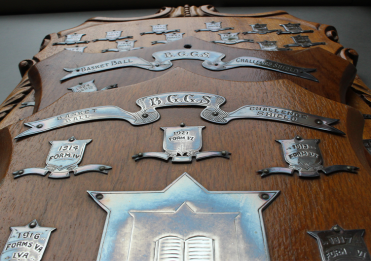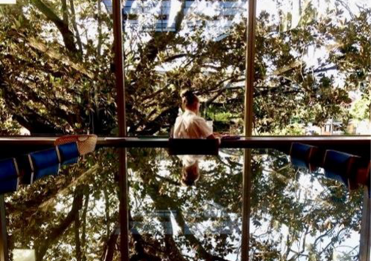The Gailey-designed Main Building was intended to include all major facilities required of a school, but the forward-looking Head Mistresses and Trustees of Brisbane Girls Grammar School soon saw a future beyond that one structure. Their vision for this School included a curriculum that matched their progressive and radical philosophy: that girls deserve the same opportunities and the same choices at school, and beyond, as the boys. Possibly, the most profound of those choices included education in the sciences.
Head Mistresses were clear from the very beginning that the quality of the girls’ education was dependent on appropriate curriculum choices, the most qualified teachers, and the best facilities. Therefore, the next stage of the building program—albeit 30 years later—was to construct two matching buildings on either side of the Main Building that would provide extra, specialised classrooms and add symmetry to the streetscape. The building on the eastern side was to house a Science laboratory and, tucked away in the map drawers within the depths of the School archive, are 1918 sketch plans for this facility. Such precise, hand-drawn, and annotated sketches reveal the importance not only placed on the encouragement of scientific scholarship, but also the creation of an inspiring space within which to work.

1918, the first concept for Science facilities
It was not until 1933, however, that this Eastern building was constructed to house a dedicated Science laboratory. The plans for this building reveal a more ambitious structure than the 1918 plans and are a thing of beauty in themselves. What they also show is the covered walkway that, still to this day, links the ‘new Science room’ to Main Building. This access was matched with a second covered way—now demolished—that joined Main Building to the Western Wing. I remember this second covered walkway fondly. It certainly sheltered your access on rainy days and was the backdrop for so many of my official School photographs. These covered walkways matched one another exactly and gave the School the intended elegant symmetry that has since been lost. However, I was delighted that the 1930s balustrades were replicated on the restored verandah and new steps were put in on the far side of the lower level of the Western Wing. What a shame that, when the upper level of the Western Wing was added in 1956, they erected iron railings rather than matching wooden ones.

Detailed and more ambitious plans for the 1933 building (Queensland State Archives)
The construction of the laboratory was considered newsworthy enough for its construction to be reported in the Brisbane Courier (24 February 1933, p7). The news item detailed that it would be ‘fully equipped with demonstration desk and platform, six students’ benches, microscope and specimen cupboards, chairs, etc. Electric light will be installed’. The cost was reported as 3313 pounds.
The opening of the laboratory on this very date 90 years ago, was welcomed by the students as much as, I assume, by the teachers, who had long anticipated its arrival. In the editorial of the 1933 School Magazine, the student editor proudly announced that the new building was opened by the Official Visitor to the School, Sir Leslie Orme Wilson, Governor of Queensland. Dr J Lockhart Gibson, Chairman of the Board of Trustees, spoke at the opening, expressing his belief that the teaching of Science at secondary schools was ‘more important really for those who did not go on to University education, because Science, more than any other subject in the school curriculum, taught them to reason. It taught them to search after the truth’ (Brisbane Courier, 26 August 1933, p12).
While, as an English teacher, I might take issue with Dr Gibson—believing that all subjects do exactly what he ascribes to Science—I cannot disagree with his idea that the curriculum must promote critical thinking and the search for truth.
The opening, graced by dignitaries, was obviously a special occasion to be celebrated with bunting made from sporting pennants and an audience of Grammar girls in their practical and stylish straw Panama hats.

1933, School Magazine December, p17
Photographs, and generations of Grammar girls to this very day, can attest to the validity of the description of the ‘fine laboratory’ as ‘airy’. Its array of large windows and the high ceiling gave wonderful light and air circulation, long before COVID reminded us of the importance of such matters.

1939, VI Form—a well-behaved class in the lab. Looks like filling from the back is not a modern behaviour!
The solid silky-oak cabinets were specially designed to hold the scientific equipment, with some artfully displayed behind glass doors.

1933, interior of the new Science laboratory
The other Queensland feature of this building was the provision of the verandah and lattice to protect the rooms from the Western sun.

1935, looking back to the 'new Science room'
Originally, the understory of the building was open and must have provided social gathering space for the students. However, as the School grew it was not long before such areas were enclosed, as the below photograph reveals.

Left—1939, Betty Datson (1940), centre, walking down what was to become Gehrmann Lane with two school friends. The door to 'the dungeon' is clearly visible; Right—2023, same place, how different!
In the 1939 shot, three Grammar girls walk down a rather rough track. It is interesting for several reasons: it provides a view back towards the 1933 Science building with its open verandah, part of which was enclosed in 1954 to provide another Science classroom; it shows the skyline and trees that would later disappear with the construction of the 1964 Eastern Wing for Science, later extended in 1969; it was the precursor to the modern and significant Gehrmann Lane (right); and it reveals the enclosed space underneath which, in my days at School, was called ‘the dungeon’.
I do not know what that quirky ‘dungeon’ space was originally intended to accommodate, but my sister had Year 11 English within its confines, and I taught there after my return as a staff member in 1972. It was gloomy with brick columns intruding into the space. There were two levels, with half the class in the ‘dress circle’ at the back. There was something slightly creepy and medieval about it.
This was only one in a series of changes to the Science building. From the 1918 vision of one classroom, to the 1933 building, and the multi-storey 2020 facility, there have been a litany of refurbishments, modernisations, and extensions to the Science facilities at the School. While the newest Science building is a stunning addition to the Gregory Terrace campus, it is wonderful that this charming cottage-like structure survived and still pleases the eye. I am sure the Mathematics teachers and classes who have moved into, what were the Science laboratories, enjoy the space, but probably have never seen those charming 1918 plans that were the advent of a building still in use after 90 years.
Mrs Kristine Cooke (Harvey, 1967)
English Teacher

1961-2—an almost balletic posed photograph of Science students. 2023 students still wear the lab coats—but where are the safety goggles?
References
1933 Brisbane Girls Grammar School Magazine December p17.
Brisbane Courier ‘New Science Room at Brisbane Girls’ Grammar’ 24 February 1933, p7.
Brisbane Courier ‘Study by Girls. Science Laboratory. Opened by the Governor.’ 26 August 1933, p12.

Left—1946, North East aspect of the Main Building with the 'covered way' to the Science laboratory. Right—same angle, but how wonderful that so much has been retained

In 1940 (left) and 2023 (right), the Science laboratory is almost hidden by trees, as seen from Gregory Terrace

1958—the Science laboratory and Main Building from where G Block now stands

A 1943 view that shows the two end columns now removed




